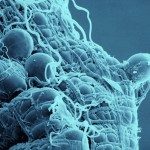Link to Pubmed [PMID] – 18985729
Cytometry B Clin Cytom 2009 May;76(3):191-8
BACKGROUND: Activation of red blood cell is associated with the formation of red cell-derived microparticles (RMPs). Analysis of circulating RMPs is becoming more refined and clinically useful. A quantitative Trucount tube method is the conventional method uses for quantitating RMPs. In this study, we validated a quantitative method called “flow rate based assay using red cell bead (FCB)” to measure circulating RMPs in the peripheral blood of healthy subjects.
METHODS: Citrated blood samples collected from 30 cases of healthy subjects were determined the RMPs count by using double labeling of annexin V-FITC and anti-glycophorin A-PE. The absolute RMPs numbers were measured by FCB, and the results were compared with the Trucount or with flow rate based calibration (FR). Statistical correlation and agreement were analyzed using linear regression and Bland-Altman analysis.
RESULTS: There was no significant difference in the absolute number of RMPs quantitated by FCB when compared with those two reference methods including the Trucount tube and FR method. The absolute RMPs count obtained from FCB method was highly correlated with those obtained from Trucount tube (r(2) = 0.98, mean bias 4 cell/microl, limit of agreement [LOA] -20.3 to 28.3 cell/microl), and FR method (r(2) = 1, mean bias 10.3 cell/microl, and LOA -5.5 to 26.2 cell/microl).
CONCLUSION: This study demonstrates that FCB is suitable and more affordable for RMPs quantitation in the clinical samples. This method is a low cost and interchangeable to latex bead-based method for generating the absolute counts in the resource-limited areas.

